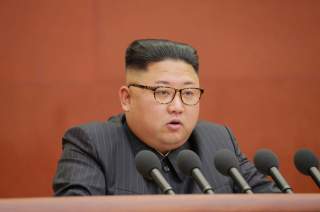Why 2017 Was Kim Jong-un's Year
And why 2018 could be very dangerous.
In his 2017 New Year’s address, North Korean leader Kim Jong-un claimed that ‘an epochal turn was brought about in consolidating the defence capability of juche Korea’ and that the country had ‘achieved the status of a nuclear power, a military giant, in the East which no enemy, however formidable, would dare to provoke’.
In response, regarding North Korea’s capability to launch an intercontinental ballistic missile (ICBM) capable of reaching the United States, US President Donald Trump tweeted: ‘It won’t happen’.
In the 11 months since, Kim Jong-un has repeatedly announced a series of accomplishments in his missile and nuclear programs that have diversified and expanded North Korea’s capability to strike targets (including the United States).
The February launch of the solid-fuel mobile Pukkuksong-2 missile signalled efforts to develop missiles with a more stable fuel supply. This occurred in the same month that North Korea demonstrated its willingness to use chemical weapons by assassinating Kim Jong-un’s half-brother Kim Jong-nam at Kuala Lumpur International Airport using the VX agent. North Korea then conducted intermediate range ballistic missile tests, initially on a lofted trajectory and then in September on a standard trajectory over Japan. These demonstrated a range sufficient to reach the US island of Guam.
Recommended: 8 Million People Could Die in a War with North Korea
Recommended: Why North Korea Is Destined to Test More ICBMs and Nuclear Weapons
Recommended: 5 Most Powerful Aircraft Carriers, Subs, Bombers and Fighter Aircraft Ever
Successful tests of the Hwasong-14 ICBM in July and Hwasong-15 ICBM in November demonstrated, in the words of US Defense Secretary Jim Mattis, North Korea’s efforts to build ballistic missiles that can target ‘anywhere in the world’. North Korea’s test in September of a thermonuclear device generated a 160–300 kiloton yield, which is 10–15 times more powerful than the tests that North Korea had previously conducted.
With these military developments in 2017, North Korea has achieved a capability that Trump said would not happen. The only remaining obstacle to a functional ICBM capability is the question of how to master atmospheric re-entry of an ICBM payload without the missile blowing up.
North Korea’s accomplishments have provided Kim with plenty of opportunities to mobilize domestic political support in Pyongyang through mass rallies held to celebrate major advances in North Korea’s nuclear and missile programs. North Korea’s expanded capabilities provide Pyongyang with added nuclear deterrence and are generating stress and anxiety in both South Korea and Japan regarding the credibility of US assurances that it will defend the two countries in the event of an attack from North Korea.
On the economic side, the results are mixed on Kim Jong-un’s strategy of ‘byungjin’ — the strategy of simultaneous military and economic development. The Seoul-based Bank of Korea reported that North Korea’s GDP in 2016 had grown by 3.9 per cent, with other sources claiming that Kim’s embrace of marketization has achieved even higher growth rates in Pyongyang.
While North Korea’s increased interdependence with the global economy has provided resources for nuclear and missile development, the relevant connections have been targeted by UN Security Council resolutions against North Korea. The latest resolutions include sectoral bans on exports of natural resources such as coal and other special metals, textiles, fishery products as well as financial sector and maritime restrictions and caps on North Korean imports of oil and exports of labor.
These sanctions seek to squeeze the umbilical cord of supplies between North Korea and China and to impose North Korean economic failure as the price of its dramatic military success. The Trump administration appears ready to take unilateral financial measures against North Korea and its customers in the name of self-defense rather than depending solely on China’s cooperation to put pressure on North Korea.
While Kim asserts that ‘equilibrium’ with the United States will remove discussion of the military option, his quest for stability by seeking reciprocal nuclear vulnerability with the United States has increased rather than decreased US consideration of military options and has bolstered US concern about the dangers of a continuously expanding nuclear arsenal in the hands of the totalitarian leader.
The contest between North Korea forcing the United States to accept its vulnerability to a nuclear North Korea and US efforts to mobilize the international isolation of North Korea to force Kim to reverse course will spill over into 2018. Both sides will remain deadlocked despite North Korea having achieved almost all the capabilities necessary to reach the United States with a nuclear strike.
The situation will likely become even more dangerous in time as both sides redouble their efforts in order to claim victory and avoid the possibility of a sudden death shoot out.
Scott Snyder is Senior Fellow for Korea Studies at the Council on Foreign Relations and is the author of South Korea at the Crossroads: Autonomy and Alliance in an Era of Rival Powers.
This article is part of an EAF special feature series on 2017 in review and the year ahead, where this first appeared.

